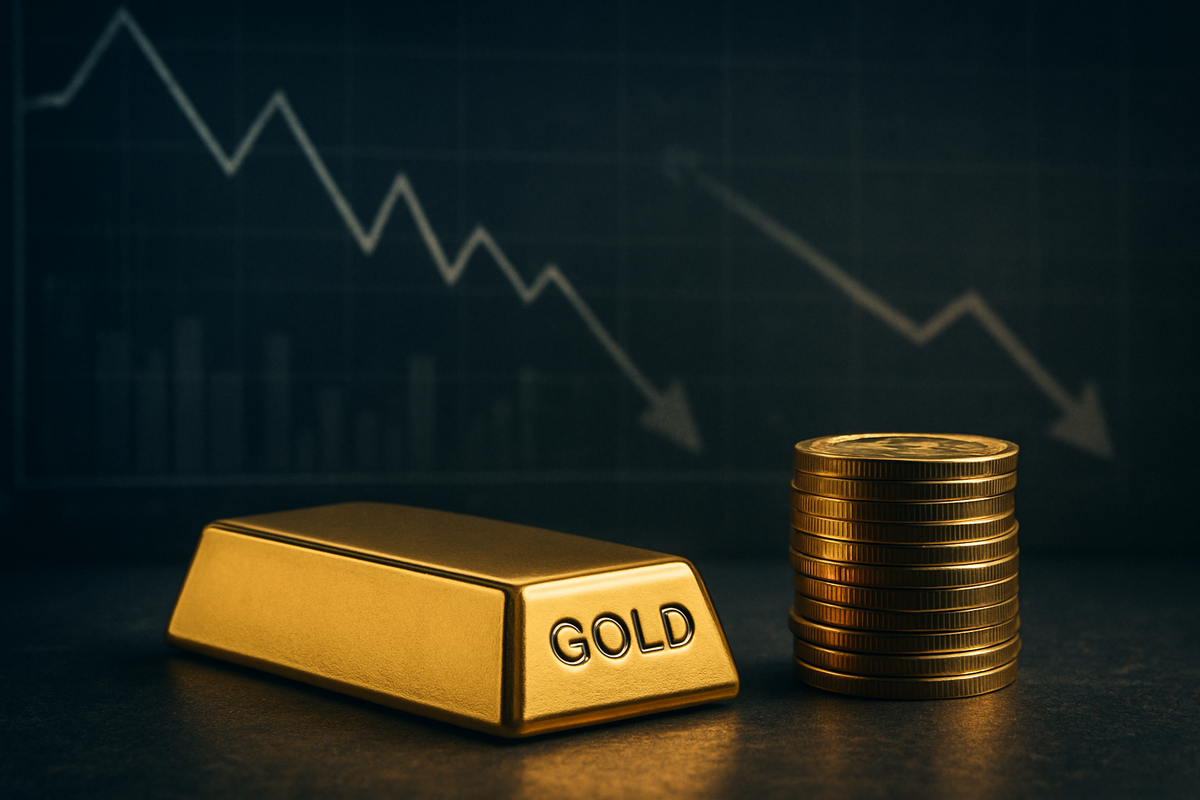
Recent weeks have seen a notable shift in the financial landscape, as a steady stream of soft economic data from the United States has significantly bolstered market expectations for imminent Federal Reserve interest rate cuts. This burgeoning sentiment has, in turn, unleashed a powerful rally in gold prices, with the precious metal surging to a two-week high and signaling a broader recalibration of investor strategies amidst growing economic uncertainty. The confluence of a weakening labor market, subdued consumer confidence, and manufacturing contraction is painting a picture of an economy losing steam, compelling the central bank to consider a more accommodative monetary policy.
As of November 10, 2025, traders are aggressively pricing in a high probability of a December rate cut, with projections for early 2026 cuts even higher. This pivot towards easier monetary policy is primarily driven by concerns that the U.S. economy may be heading for a significant slowdown, if not an outright recession. For gold, a non-yielding asset, the prospect of lower interest rates diminishes the opportunity cost of holding it, enhancing its allure as both a store of value and a safe haven against economic headwinds and a weakening U.S. dollar.
Weakening Economic Indicators Cement Dovish Fed Outlook
The narrative of a softening U.S. economy has been meticulously built over recent months through a series of key economic reports. The labor market, once a bastion of strength, has shown significant cracks. October 2025 witnessed job losses, particularly in government offices and retail, with Challenger jobs data revealing the worst round of layoffs in approximately two decades. This was further underscored by the Automatic Data Processing (ADP) National Employment Report for October, which indicated a meager increase of just 42,000 private sector jobs, a stark contrast to earlier robust growth. Moreover, a substantial benchmark revision by the Bureau of Labor Statistics (BLS) revealed that job growth from March 2024 to March 2025 was overestimated by a staggering 911,000 jobs, marking the largest downward adjustment on record and painting a clearer picture of a cooling employment landscape. The unemployment rate has steadily climbed, reaching 4.3% in August 2025—its highest since October 2021—with forecasts suggesting a potential rise to 4.5% for October.
Beyond employment, consumer sentiment has taken a significant hit. The University of Michigan Consumer Sentiment Index plummeted in early November 2025 to 50.3, its lowest level in nearly three and a half years, reflecting increasing public concern over financial conditions and economic stability. The manufacturing sector has also continued its contraction, as evidenced by the September Institute for Supply Management (ISM) manufacturing report, which showed the Purchasing Managers Index (PMI) at 49.1. Adding to the economic anxieties, a prolonged 40-day U.S. government shutdown has delayed crucial official data releases and impacted federal employment, contributing to overall market uncertainty.
These accumulating signs of economic deceleration have profoundly influenced the Federal Reserve's stance and market expectations. The CME FedWatch Tool, as of November 10, 2025, indicates a high probability (around 60-67%) of a Federal Reserve rate cut in December, with projections for a January cut climbing even higher to approximately 80%. While Fed Chair Jerome Powell had initially tempered expectations for aggressive easing after the October meeting, stating a December cut was "far from a foregone conclusion," the relentless stream of weak data has seemingly shifted the Fed's focus from primarily inflation risks to heightened concerns about employment and economic growth. This renewed dovish outlook has immediately translated into a surge for spot gold prices, which broke past the $4,070 per ounce mark, climbing approximately 1.8% to 2.1%, with U.S. gold futures for December delivery also advancing significantly. The U.S. dollar, inversely, has shown weakness, slipping below the 100 threshold on the dollar index, further enhancing gold's attractiveness.
Corporate Fortunes: Who Wins and Who Loses in a Dovish Shift
The shift towards a lower interest rate environment, coupled with surging gold prices, is poised to reshape the fortunes of various public companies and sectors. This dual dynamic creates clear winners and losers, necessitating strategic adjustments across the market.
On the winning side, sectors that are highly sensitive to borrowing costs stand to gain significantly from sustained lower interest rates. The Technology sector is a prime beneficiary, as growth-oriented tech companies often rely on external funding for aggressive research, development, and expansion. Cheaper capital not only fuels innovation but also boosts the present value of their long-term future earnings, making companies like Apple (NASDAQ: AAPL), Alphabet (NASDAQ: GOOGL), and Meta Platforms (NASDAQ: META) more attractive to investors. Similarly, the Consumer Discretionary sector thrives when borrowing costs for consumers decrease, leading to increased spending power. Retail giants such as Target (NYSE: TGT), Walmart (NYSE: WMT), and Costco (NASDAQ: COST) could see a boost in demand for non-essential goods and services. The Real Estate and Home Construction sectors are also set for a resurgence, as lower mortgage rates stimulate home buying and cheaper financing encourages new construction projects. Companies like Builders FirstSource (NASDAQ: BLDR) and Mohawk Industries (NYSE: MHK) are well-positioned to capitalize on renewed activity in the housing market. Furthermore, Utilities, often sought for their stable dividends, become more appealing in a low-yield environment, while highly leveraged companies and small-cap stocks can see their interest expenses reduced, improving their profitability.
Conversely, some sectors face headwinds. Financials, particularly banks and insurance companies, typically suffer from compressed net interest margins (NIMs) when interest rates fall. The difference between what they earn on loans and what they pay on deposits narrows, impacting profitability. While large institutions like JPMorgan Chase (NYSE: JPM) or Bank of America (NYSE: BAC) have diversified revenue streams, a sustained low-rate environment can still challenge their core lending businesses. Companies holding substantial cash reserves or those whose business models depend on earning interest on those reserves will also see reduced income as yields on cash investments decline.
The surge in gold prices, driven by safe-haven demand and reduced opportunity cost, creates a direct boon for Gold Mining Companies. Higher gold prices directly translate to increased revenues and wider profit margins for producers like Newmont (NYSE: NEM), Barrick Gold (NYSE: GOLD), and Agnico Eagle Mines (NYSE: AEM). These companies can see their cash flows swell, potentially leading to increased dividends or share buybacks. Gold Streaming and Royalty Companies, such as Franco-Nevada (NYSE: FNV) and Wheaton Precious Metals (NYSE: WPM), also benefit without bearing the direct operational risks of mining, as they receive a percentage of future production or the right to purchase metals at a fixed, low price. Finally, Precious Metals Exchange-Traded Funds (ETFs), which offer broad exposure to physical gold or gold mining stocks, will see their values appreciate, attracting greater investor interest. The combined effect of lower rates making gold more attractive and economic uncertainty driving safe-haven demand creates a powerful tailwind for the entire precious metals complex.
Broader Implications: A Shifting Global Economic Landscape
The Federal Reserve's pivot towards a more dovish monetary policy, spurred by weakening U.S. economic data, carries significant wider implications that extend far beyond domestic markets, reshaping global economic trends and policy considerations. This development signals a strategic shift from primarily combating inflation to prioritizing economic growth and employment, a move with profound ripple effects.
This dovish outlook fits into a broader trend of central banks globally grappling with slowing growth while attempting to manage inflation. For financial markets, while equities might experience initial volatility, historical precedents suggest that rate-cutting cycles, particularly those that successfully avert a recession, can be followed by robust equity returns. However, traditionally, banks and insurance companies may underperform due to squeezed net interest margins and declining investment returns, while defensive sectors like utilities and telecommunications tend to show resilience. Bond markets, particularly U.S. Treasuries, are likely to see continued rallies as investors seek safety and anticipate further rate cuts. In commodity markets, lower interest rates generally stimulate economic activity, which could boost demand for raw materials like oil and industrial metals. Furthermore, a weaker U.S. dollar, often a consequence of rate cuts, makes dollar-denominated commodities more affordable for international buyers, potentially driving up their prices. Gold, however, stands out as the primary commodity directly benefiting from lower U.S. interest rates, solidifying its role as an inflation hedge and a safe haven.
The global economy experiences substantial ripple effects from U.S. monetary policy due to the dollar's status as the dominant reserve currency. Lower U.S. rates can prompt capital flows towards higher-yielding assets in emerging markets, offering temporary relief to developing economies by reducing borrowing costs for dollar-denominated debt and potentially leading to currency appreciation. Many emerging market central banks have already embarked on their own easing cycles, amplifying this trend. In currency markets, a dovish Fed typically leads to a weaker U.S. dollar against other major currencies, making U.S. exports more competitive but increasing the cost of imports. This dynamic can also boost confidence in non-U.S. assets and currencies.
From a regulatory and policy standpoint, the Fed's pivot underscores its commitment to maintaining economic stability. This shift could lead to increased liquidity in financial markets, potentially prompting regulatory discussions about financial stability and the risk of asset bubbles forming. Internationally, the U.S. stance might influence other central banks, potentially leading to a synchronized global easing cycle if their economies exhibit similar signs of stress. The interplay of ongoing geopolitical factors and trade policies will also continue to shape policy decisions and market reactions, adding layers of complexity to the economic outlook.
Historically, there is a strong correlation between Fed easing cycles and rising gold prices. Gold has consistently performed well in the 24 months following the start of Fed interest rate cuts, with notable increases after the 2000, 2007, and 2019 cuts. Gold's role as a safe haven is particularly evident during periods of economic slowdowns or financial crises; for instance, it surged by 25% during the 2008 financial crisis while the S&P 500 plummeted. When the first rate cut of a cycle is followed by a recession, gold prices have historically risen by an average of 15.5% after 12 months. While real interest rates are often cited as a key driver, other factors such as inflation expectations, currency shifts, and geopolitical risks play equally dominant roles in gold's movements, reinforcing its enduring appeal as a hedge in uncertain economic landscapes.
The Road Ahead: Navigating an Evolving Economic Landscape
The current economic juncture, characterized by soft U.S. data, anticipated rate cuts, and soaring gold prices, sets the stage for a dynamic and potentially volatile period. Understanding the short-term and long-term possibilities, along with strategic pivots, will be crucial for investors and businesses alike.
In the short-term (2024-2025), the U.S. economy is projected to continue its deceleration, albeit modestly. Real GDP growth is expected to slow, and the labor market will likely cool further, with the unemployment rate potentially ticking up. Consumer spending is also anticipated to moderate, facing headwinds from a softer job market and lingering inflationary pressures. For interest rates, financial markets are aggressively pricing in further Fed cuts, with high probabilities for reductions in December 2025 and January 2026. This dovish stance is a direct response to the weakening economic indicators. Gold prices, consequently, are expected to maintain their upward momentum, fueled by lower real interest rates, persistent economic uncertainty, and continued safe-haven demand. Goldman Sachs (NYSE: GS) predicts gold could climb further to $3,100 per troy ounce by the end of 2025, with J.P. Morgan Research (NYSE: JPM) projecting an average of $3,675/oz by Q4 2025.
Looking at the long-term (beyond 2025), the U.S. economy is expected to settle into a more sustainable growth path, with output and employment growth moderating. However, persistent policy uncertainty and rising national debt could pose ongoing challenges. The Fed's long-term projections suggest a gradual normalization of interest rates, though the exact trajectory remains data-dependent. For gold, the long-term outlook remains decidedly bullish. Forecasts from major institutions suggest prices could reach $4,400 to $5,000 per ounce by 2026, with some predicting over $5,000 by 2030. This sustained growth is underpinned by continued strong central bank demand, particularly from emerging economies diversifying away from the U.S. dollar, and ongoing geopolitical and economic uncertainties. The "de-dollarization" trend further solidifies gold's role as a long-term inflation hedge and store of value.
Strategic pivots will be essential for various stakeholders. The Federal Reserve's policy is "not on a pre-set course," meaning future decisions will be highly data-dependent. Investors, meanwhile, might consider increasing their allocation to gold, potentially up to 10% of a portfolio, as a hedge against stagflation, recession, currency debasement, and U.S. policy risks. Utilizing gold Exchange Traded Funds (ETFs) and diversifying across physical gold and mining stocks are viable strategies. Gold mining companies will need to prioritize operational efficiencies, manage global supply chains, and navigate currency risks to capitalize on higher prices while mitigating cost pressures.
Market opportunities lie in the continued strength of gold and other precious metals, driven by rate cut expectations and central bank demand. Silver, in particular, stands to benefit from the accelerating global energy transition due to its critical role in solar power and electric vehicles. Conversely, challenges include the inherent uncertainty of Fed policy, where any hawkish commentary could temper gold's rally. A stronger-than-expected U.S. dollar could also negatively impact gold prices, while high-cost gold producers may struggle if prices remain subdued for extended periods.
Several potential scenarios could unfold. A "soft landing" with gradual Fed rate cuts would likely see gold prices remain well-supported, testing new highs as real interest rates decline. A deeper economic downturn or recession, however, could trigger a substantial flight to safety, propelling gold prices significantly higher. Conversely, a hawkish Fed pivot or a surprisingly robust economic rebound might lead to a temporary correction in gold. Finally, persistent geopolitical instability and a continued trend towards "de-dollarization" would provide a strong structural bull case for gold, driving prices to unprecedented long-term levels.
Conclusion: A Golden Opportunity Amidst Economic Uncertainty
The current financial narrative is unequivocally shaped by the softening U.S. economic data, which has decisively cemented market expectations for Federal Reserve interest rate cuts. This dovish pivot, driven by concerns over slowing growth and employment, has ignited a significant rally in gold prices, underscoring the precious metal's enduring appeal as a safe-haven asset in times of uncertainty and lower real interest rates.
Key takeaways from this evolving situation include the clear shift in the Fed's priorities towards supporting economic activity, the direct positive correlation between anticipated rate cuts and gold's valuation, and the subsequent re-evaluation of investment strategies across various sectors. While technology, consumer discretionary, and real estate sectors stand to benefit from cheaper capital, financials face margin compression. Gold mining companies and related investment vehicles are poised for substantial gains, leveraging the surge in gold prices.
Moving forward, the market will be closely watching incoming economic data for further signals on the pace and extent of the Fed's easing cycle. Investors should monitor the unemployment rate, inflation figures, and consumer sentiment indices, as these will be critical in shaping future monetary policy. Geopolitical developments and central bank gold purchasing trends will also continue to exert significant influence on gold's trajectory.
The confluence of factors—economic deceleration, a dovish Fed, and rising gold prices—presents both opportunities and risks. For those seeking hedges against potential economic instability and currency debasement, gold offers a compelling proposition. However, vigilance against unexpected shifts in Fed policy or a stronger-than-anticipated economic rebound is paramount. The coming months will undoubtedly test market resilience and reveal the true depth of the U.S. economic slowdown, with gold likely to remain a key barometer of investor sentiment.
This content is intended for informational purposes only and is not financial advice




